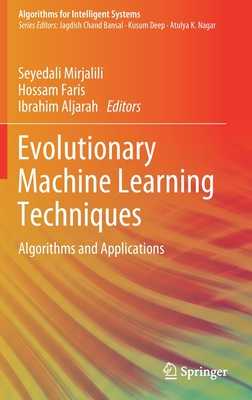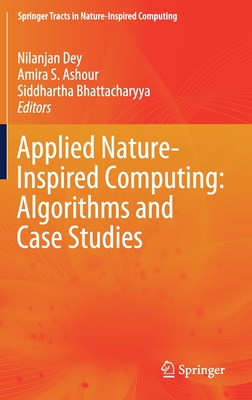買這商品的人也買了...
-
 Swarm Intelligence (Hardcover)
Swarm Intelligence (Hardcover)$4,280$4,066 -
 Learning and Soft Computing: Support Vector Machines, Neural Networks, and Fuzzy Logic Models (Hardcover)
Learning and Soft Computing: Support Vector Machines, Neural Networks, and Fuzzy Logic Models (Hardcover)$2,200$2,156 -
 Windows 程式設計使用 MFC (Programming Windows with MFC, 2/e)
Windows 程式設計使用 MFC (Programming Windows with MFC, 2/e)$990$782 -
 Linux iptables 技術實務─防火牆、頻寬管理、連線管制
Linux iptables 技術實務─防火牆、頻寬管理、連線管制$620$527 -
 深入淺出設計模式 (Head First Design Patterns)
深入淺出設計模式 (Head First Design Patterns)$880$695 -
 深入淺出 Java 程式設計, 2/e (Head First Java, 2/e)
深入淺出 Java 程式設計, 2/e (Head First Java, 2/e)$880$695 -
 Java 認證 SCJP 5.0 猛虎出閘
Java 認證 SCJP 5.0 猛虎出閘$650$514 -
 SQL Server 2005 資料庫開發聖經
SQL Server 2005 資料庫開發聖經$890$757 -
 鳥哥的 Linux 私房菜基礎學習篇, 2/e
鳥哥的 Linux 私房菜基礎學習篇, 2/e$780$663 -
 Microsoft SQL Server 2005 設計實務
Microsoft SQL Server 2005 設計實務$680$578 -
 世界是平的 (The World Is Flat)
世界是平的 (The World Is Flat)$390$332 -
 ASP.NET 2.0 深度剖析範例集
ASP.NET 2.0 深度剖析範例集$650$507 -
 專案管理黑皮書
專案管理黑皮書$270$213 -
 Ruby on Rails 網路應用程式開發與建置
Ruby on Rails 網路應用程式開發與建置$520$406 -
 時間管理─給系統管理者 (Time Management for System Administrators)
時間管理─給系統管理者 (Time Management for System Administrators)$480$379 -
 Visual Basic 2005 程式設計與案例剖析
Visual Basic 2005 程式設計與案例剖析$650$553 -
 SQL Server 2005 OLAP 線上即時分析
SQL Server 2005 OLAP 線上即時分析$680$537 -
 ASP.NET 2.0 開發指南-使用 C#
ASP.NET 2.0 開發指南-使用 C#$650$514 -
 次世代─Linux Ubuntu 玩全手冊
次世代─Linux Ubuntu 玩全手冊$580$493 -
 聖殿祭司的 ASP.NET 2.0 專家技術手冊-使用 VB
聖殿祭司的 ASP.NET 2.0 專家技術手冊-使用 VB$720$569 -
 數位影像處理技術手冊
數位影像處理技術手冊$320$253 -
 C++ Primer, 4/e (中文版)
C++ Primer, 4/e (中文版)$990$891 -
 $2,240Computational Intelligence: Concepts to Implementations (Hardcover)
$2,240Computational Intelligence: Concepts to Implementations (Hardcover) -
 簡單‧圖解程式設計 Programming 的優質入門書
簡單‧圖解程式設計 Programming 的優質入門書$450$351 -
 Computational Intelligence: An Introduction, 2/e (Hardcover)
Computational Intelligence: An Introduction, 2/e (Hardcover)$1,600$1,568
相關主題
商品描述
Description
Fundamentals of Computational Swarm Intelligence Provides a comprehensive introduction to the new computational paradigm of swarm intelligence (SI), a field that emerged from biological research, and which is now picking up momentum within the computational research community. Bio-inspired systems are becoming increasingly important research areas for computer scientists, engineers, economists, bioinformaticians, operational researchers, and many other disciplines. This book introduces the reader to the mathematical models of social insects' collective behaviour, and shows how they can be used in solving optimization problems.
Focusing on the algorithmic of modes of swarm behaviour, this book:
The interdisciplinary nature of this field will make Fundamentals of Computational Swarm Intelligence an essential resource for readers with diverse backgrounds. Practitioners in business or industry and researchers involved in the analysis, design and simulation of multibody systems. Advanced undergraduates and graduate students in artificial intelligence, collective intelligence and engineering will also find this book an invaluable tool.
Table of Contents
List of Tables.
List of Figures.
List of Algorithms.
Preface.
1. Introduction.
PART I: OPTIMIZATION THEORY.
2. Optimization Problems and Methods.
2.1 Basic ingredients of optimization problems.
2.2 Optimization problem classifications.
2.3 Optimality conditions.
2.4 Optimization method classes.
2.5 General conditions for convergence.
2.6 Summary.
3. Unconstrained Optimization.
3.1 Problem definition.
3.2 Optimization algorithms.
3.3 Example benchmark problems.
3.4 Summary.
4. Constrained Optimization.
4.1 Definition.
4.2 Constraint handling methods.
4.3 Example benchmark problems.
4.4 Summary.
5. Multi-solution Problems.
5.1 Definition.
5.2 Niching algorithm categories.
5.3 Example benchmark problems.
5.4 Summary.
6. Multi-objective Optimization.
6.1 Multi-objective problem.
6.2 Pareto-optimality.
6.3 Summary.
7. Dynamic Optimization Problems.
7.1 Definition.
7.2 Dynamic environment types.
7.3 Example benchmark problems.
7.4 Summary.
PART II: EVOLUTIONARY COMPUTATION.
8. Introduction to Evolutionary Computation.
8.1 General evolutionary algorithm.
8.2 Representation.
8.3 Initial population.
8.4 Fitness function.
8.5 Selection.
8.6 Reproduction operators.
8.7 Evolutionary computation versus classical optimization.
8.8 Summary.
9. Evolutionary Computation Paradigms.
9.1 Genetic algorithms.
9.2 Genetic programming.
9.3 Evolutionary programming.
9.4 Evolution strategies.
9.5 Differential evolution.
9.6 Cultural algorithms.
9.7 Summary.
10. Coevolution.
10.1 Competitive coevolution.
10.2 Cooperative coevolution.
10.3 Summary.
PART III: PARTICLE SWARM OPTIMIZATION.
11. Introduction.
12. Basic Swarm Optimization.
12.1 Full PSO model.
12.2 Social network structures.
12.3 Basic variations.
12.4 Basic PSO parameters.
12.5 Performance measures.
12.6 PSO versus EC.
12.7 Summary.
13. Particle Trajectories.
13.1 Convergence.
13.2 Surfing the waves.
13.3 Swarm equilibrium.
13.4 Constricted trajectories.
13.5 Unconstricted trajectories.
13.6 Parameter selection heuristics.
13.7 Summary.
14. Convergence Proofs.
14.1 Convergence proof for basic PSO.
14.2 PSO with guaranteed local convergence.
14.3 Global convergence of PSO.
14.4 Summary.
15. Single-Solution Particle Swarm Optimization.
15.1 Social based PSO algorithms.
15.2 Hybrid algorithms.
15.3 Sub-swarm-based PSO.
15.4 Memetic PSO algorithms.
15.5 Multi-start PSO algorithms.
15.6 Repelling methods.
15.7 Summary.
16. Niching with Particle Swarm Optimization.
16.1 Niching capability of basic PSO.
16.2 Sequential PSO niching.
16.3 Parallel PSO niching.
16.4 Quasi-sequential niching.
16.5 Performance measures.
16.6 Summary.
17. Constrained Optimization Using Particle Swarm Optimization.
17.1 Reject infeasible solutions.
17.2 Penalty function methods.
17.3 Convert to unconstrained problems.
17.4 Repair methods.
17.5 Preserving feasibility methods.
17.6 Pareto ranking methods.
17.7 Boundary constraints.
17.8 Applications.
17.9 Summary.
18. Multi-Objective Optimization with Particle Swarms.
18.1 Objectives of MOO.
18.2 Basic PSO versus MOO.
18.3 Aggregation-based methods.
18.4 Criterion-based methods.
18.5 Dominance-based methods.
18.6 Performance measures.
18.7 Summary.
19. Dynamic Environments with Particle Swarm Optimization.
19.1 Consequences for PSO.
19.2 PSO solutions for dynamic environments.
19.3 Performance measurement in dynamic environments.
19.4 Applications of PSO to dynamic problems.
19.5 Summary.
20. Discrete Particle Swarm Optimization.
20.1 Binary PSO.
20.2 General Discrete PSO.
20.3 Example applications.
20.4 Design of combinational circuits.
20.5 Summary.
21. Particle Swarm Optimization Applications.
21.1 Neural networks.
21.2 Game learning.
21.3 Clustering applications.
21.4 Design applications.
21.5 Scheduling and planning applications.
21.6 Controllers applications.
21.7 Applied mathematics.
21.8 Applications in power systems.
21.9 Miscellaneous applications.
21.10 Summary.
PART VI: ANT ALGORITHMS.
22. Introduction.
23. Ant Colony Optimization Meta-Heuristic.
23.1 Foraging behaviour of ants.
23.2 Simple ant colony optimization.
23.3 Early ant algorithms.
23.4 Parameter settings.
23.5 Summary.
24. General Frameworks for Ant Colony Optimization Algorithms.
24.1 ACO algorithms characteristics.
24.2 Generic frameworks.
24.3 Summary.
25. Ant Colony Optimization Algorithms.
25.1 Single colony ACO algorithms.
25.2 Continuous ACO.
25.3 Multiple colony algorithms.
25.4 Hybrid ACO algorithms.
25.5 Multi-objective optimization.
25.6 Dynamic optimization problems.
25.7 Parallel ACO algorithms.
25.8 Summary.
26. Ant Colony Optimization Applications.
26.1 General requirements.
26.2 Ordering problems.
26.3 Assignment problems.
26.4 Subset problems.
26.5 Grouping problems.
26.6 Summary.
27. Collective Decision-Making.
27.1 Stigmergy.
27.2 Artificial Pheromone.
27.3 Heterarchy.
27.4 Summary.
28. Ant Colony Optimization Convergence.
28.1 Convergence proofs and characteristics.
28.2 Convergence measures.
28.3 Summary.
29. Cemetery Organisation and Brood Care.
29.1 Basic ant colony clustering model.
29.2 Generalized ant colony clustering model.
29.3 Minimal model for ant clustering.
29.4 Ant clustering ensemble.
29.5 Hybrid clustering approaches.
29.6 Ant clustering applications.
29.7 Summary.
30. Division of Labor.
30.1 Division of labor in insect colonies.
30.2 Task allocation based on response thresholds.
30.3 Adaptive task allocation and specialization.
30.4 Summary.
31. Final Remarks.
References.
Further Reading.
Appendix A: Acronyms.
Appendix B: Symbols.
B.1 Part I - Optimization Theory.
B.2 Part II - Evolutionary Computation.
B.3 Part III - Particle Swarm Optimization.
B.4 Part IV - Ant Algorithms.
Index.
商品描述(中文翻譯)
《計算群體智慧的基本原理》提供了對新計算範式群體智慧(Swarm Intelligence, SI)的全面介紹,這是一個源於生物研究的領域,現在在計算研究社群中逐漸獲得動力。受生物啟發的系統正變得越來越重要,成為計算機科學家、工程師、經濟學家、生物信息學家、運籌學研究者及許多其他學科的研究領域。本書向讀者介紹社會性昆蟲集體行為的數學模型,並展示如何利用這些模型來解決優化問題。
本書專注於群體行為的算法模式,內容包括:
- 檢視社交網絡結構如何用於改變個體之間的信息,以及這些個體的聚合行為如何形成一個強大的有機體。
- 介紹優化的正式理論的簡明摘要。
- 概述與群體智慧相關的範式,包括遺傳算法、進化編程、進化策略、文化算法和共同進化。
- 研究鳥群的舞蹈動作作為粒子群優化(Particle Swarm Optimization, PSO)不同類別模型的基礎。
- 展示如何利用螞蟻的行為來實現螞蟻群體優化(Ant Colony Optimization, ACO)算法,以解決現實世界中的問題,包括路由優化、結構優化、數據挖掘和數據聚類。
- 考慮不同類別的優化問題,包括多目標優化、動態環境、離散和連續搜索空間、約束優化和生態位。
- 包含一個附屬網站,提供不同算法的 Java 類和實現,可用於測試 PSO 和 ACO 算法: http://si.cs.up.ac.za
這一領域的跨學科特性使《計算群體智慧的基本原理》成為具有多元背景讀者的重要資源。商業或工業界的從業者以及參與多體系統分析、設計和模擬的研究者,人工智慧、集體智慧和工程的高年級本科生及研究生也會發現本書是不可或缺的工具。
目錄
- 表格清單
- 圖形清單
- 算法清單
- 前言
- 1. 介紹
- 第一部分:優化理論
- 2. 優化問題與方法
- 2.1 優化問題的基本成分
- 2.2 優化問題分類
- 2.3 最優條件
- 2.4 優化方法類別
- 2.5 收斂的一般條件
- 2.6 總結
- 3. 無約束優化
- 3.1 問題定義
- 3.2 優化算法
- 3.3 示例基準問題
- 3.4 總結
- 4. 有約束優化
- 4.1 定義
- 4.2 約束處理方法
- 4.3 示例基準問題
- 4.4 總結
- 5. 多解問題
- 5.1 定義
- 5.2 生態位算法類別
- 5.3 示例基準問題
- 5.4 總結
- 6. 多目標優化
- 6.1 多目標問題
- 6.2 帕累托最優性
- 6.3 總結
- 7. 動態優化問題
- 7.1 定義
- 7.2 動態環境類型
- 7.3 示例基準問題
- 7.4 總結
- 第二部分:進化計算
- 8. 進化計算簡介
- 8.1 一般進化算法
- 8.2 表示
- 8.3 初始種群
- 8.4 適應度函數
- 8.5 選擇
- 8.6 繁殖操作
- 8.7 進化計算與經典優化的比較
- 8.8 總結
- 9. 進化計算範式
- 9.1 遺傳算法
- 9.2 遺傳編程
- 9.3 進化編程
- 9.4 進化策略
- 9.5 差分進化
- 9.6 文化算法
- 9.7 總結
- 10. 共同進化
- 10.1 競爭共同進化
- 10.2 合作共同進化
- 10.3 總結
- 第三部分:粒子群優化
- 11. 簡介
- 12. 基本群體優化
- 12.1 完整 PSO 模型
- 12.2 社交網絡結構
- 12.3 基本變體
- 12.4 基本 PSO 參數
- 12.5 性能度量
- 12.6 PSO 與 EC 的比較
- 12.7 總結
- 13. 粒子軌跡
- 13.1 收斂
- 13.2 衝浪波浪
- 13.3 群體平衡
- 13.4 受限軌跡
- 13.5 無限制軌跡
- 13.6 參數選擇啟發式
- 13.7 總結
- 14. 收斂證明
- 14.1 基本 PSO 的收斂證明
- 14.2 保證局部收斂的 PSO
- 14.3 PSO 的全局收斂
- 14.4 總結
- 15. 單解粒子群優化
- 15.1 基於社交的 PSO 算法
- 15.2 混合算法
- 15.3 基於子群的 PSO
- 15.4 記憶型 PSO 算法
- 15.5 多啟動 PSO 算法
- 15.6 排斥方法
- 15.7 總結
- 16. 使用粒子群優化的生態位
- 16.1 基本 PSO 的生態位能力
- 16.2 順序 PSO 生態位
- 16.3 並行 PSO 生態位
- 16.4 準順序生態位
- 16.5 性能度量
- 16.6 總結
- 17. 使用粒子群優化的有約束優化
- 17.1 拒絕不可行解
- 17.2 處罰函數方法
- 17.3 轉換為無約束問題
- 17.4 修復方法
- 17.5 保持可行性的方法
- 17.6 帕累托排名方法
- 17.7 邊界約束
- 17.8 應用
- 17.9 總結
- 18. 使用粒子群的多目標優化
- 18.1 MOO 的目標
- 18.2 基本 PSO 與 MOO 的比較
- 18.3 基於聚合的方法
- 18.4 基於標準的方法
- 18.5 基於優勢的方法
- 18.6 性能度量
- 18.7 總結
- 19. 使用粒子群的動態環境
- 19.1 對 PSO 的影響
- 19.2 動態環境的 PSO 解
- 19.3 動態環境中的性能測量
- 19.4 PSO 在動態問題中的應用
- 19.5 總結
- 20. 離散粒子群優化
- 20.1 二元 PSO
- 20.2 一般離散 PSO
- 20.3 示例應用
- 20.4 組合電路設計
- 20.5 總結
- 21. 粒子群優化應用
- 21.1 神經網絡
- 21.2 遊戲學習
- 21.3 聚類應用
- 21.4 設計應用
- 21.5 排程與規劃應用
- 21.6 控制器應用
- 21.7 應用數學
- 21.8 電力系統中的應用
- 21.9 其他應用
- 21.10 總結
- 第六部分:螞蟻算法
- 22. 簡介
- 23. 螞蟻群體優化元啟發式
- 23.1 螞蟻的覓食行為
- 23.2 簡單的螞蟻群體優化
- 23.3 早期螞蟻算法
- 23.4 參數設置
- 23.5 總結
- 24. 螞蟻群體優化算法的一般框架
- 24.1 ACO 算法特徵
- 24.2 通用框架
- 24.3 總結
- 25. 螞蟻群體優化算法
- 25.1 單一群體 ACO 算法
- 25.2 連續 ACO
- 25.3 多群體算法
- 25.4 混合 ACO 算法
- 25.5 多目標優化
- 25.6 動態優化問題
- 25.7 並行 ACO 算法
- 25.8 總結
- 26. 螞蟻群體優化應用
- 26.1 一般要求
- 26.2 排序問題
- 26.3 分配問題
- 26.4 子集問題
- 26.5 分組問題
- 26.6 總結
- 27. 集體決策
- 27.1 刺激性
- 27.2 人工費洛蒙
- 27.3 非層級結構
- 27.4 總結
- 28. 螞蟻群體優化的收斂
- 28.1 收斂證明與特徵
- 28.2 收斂度量
- 28.3 總結
- 29. 墓地組織與幼蟲護理
- 29.1 基本螞蟻群體聚類模型
- 29.2 一般化螞蟻群體聚類模型
- 29.3 螞蟻聚類的最小模型
- 29.4 螞蟻聚類集成
- 29.5 混合聚類方法
- 29.6 螞蟻聚類應用
- 29.7 總結
- 30. 分工
- 30.1 昆蟲群體中的分工
- 30.2 基於反應閾值的任務分配
- 30.3 自適應任務分配與專業化
- 30.4 總結
- 31. 最後的評論
- 參考文獻
- 進一步閱讀
- 附錄 A:縮寫
- 附錄 B:符號
- B.1 第一部分 - 優化理論
- B.2 第二部分 - 進化計算
- B.3 第三部分 - 粒子群優化
- B.4 第四部分 - 螞蟻算法
- 索引












